Imagine: You walk along your usual path on a late-summer Saturday, headphones in, enjoying the sun. A raised bed next to the path catches your attention. At first the planting looks unusual for this park: beans climbing poles, onions pushing through the soil, potatoes nestled alongside. A small sign explains the combination – together, these plants make up the ingredients for a bowl of Bouneschlupp, Luxembourg’s traditional bean soup. A few steps further, lettuce, tomatoes and grain mark out the components of a burger. What seems at first like a curious mix becomes a clear reminder that every meal is rooted in plants and land – a connection that is easy to lose sight of in an age of supermarket shelves and processed food. These raised beds are one of many installations created for the Luxembourg Urban Garden (LUGA).
From 7 May to 18 October 2025, Luxembourg is hosting its first national garden exhibition. The Luxembourg Urban Garden (LUGA) takes place across five sites in Luxembourg City and Ettelbrück in the Nordstad. Under the motto “Making the Invisible Visible”, it links gardens, installations and cultural activities with broader questions of biodiversity, water, food and sustainable urban development. More than 1,000 events are scheduled, making it a six-month programme that transforms parts of the city and beyond.
This article takes you on a virtual version of a walk through several exhibition sites of the LUGA in Luxembourg City with additional context given by the general coordinator Ann Muller. It offers a glimpse of selected gardens and installations, not the full exhibition and programme of events, which can be found here. A second article will provide more background on how LUGA was planned and organised.
Our walk begins at the LUGA Science Hub in the Pétrusse valley. As an information point and orientation space, it introduces visitors to the exhibition’s themes and sets the tone for what lies ahead. Ann Muller, general coordinator of LUGA, explains that the aim is not to show ready-made solutions but to spark questions about how cities might look in the future.
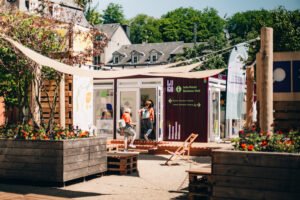
The LUGA Science Hub (source: LUGA)
From here, we continue into the recently renaturalised river valley, where ten gardens created by young designers line the river. They were selected through international competitions and all had to follow strict ecological rules. Each garden addresses its theme in a different way. One of them uses mirrors to invite a second look at so-called weeds and reintroduces them as medicinal plants. Another, titled Blue Sky, translates a piece of music into a composition of plants and colours, demonstrating how sound and visual perception can be linked. Le Portail, presents a green arch that symbolises transition and sustainability. The material choices are deliberate: recyclable wood, rented components, and plants that can be replanted elsewhere after the exhibition.
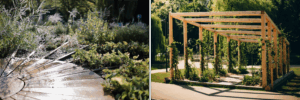
Blue Sky by Jerome Goedseels (left; source: Marion Dessard) and Le Portail by Naile Arslan (right; source: LUGA)
Close by, a set of raised beds adds a though-provoking element. Each bed represents a meal, such as Bouneschlupp soup or a burger, and shows exactly which plants are needed to prepare it. The installation makes visible how much land is required to produce food and how urban farming could play a role in future diets. Each of these gardens and installations is accompanied by signs and information boards. They explain the ideas behind the projects in simple terms, making sure the messages are accessible. At the same time, the designs integrate well into the urban landscape. They do not feel like temporary additions but become part of the city’s everyday environment for the duration of the exhibition.
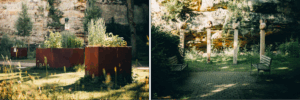
Un banquet dans une jardinière by IBLA, co-labor and natur&ëmwelt (left) and Totems by Laurent Le Deunff (right) on the art trail Animals of the Mind (source: LUGA)
All around the valley and other parts of the exhibition, an art trail curated by Boris Kremer complements the gardens with installations and performances under the title Animals of the Mind. These works deal with human–animal relationships and biodiversity loss, themes that resonate with the overall ambition of LUGA to make invisible connections in nature more tangible.
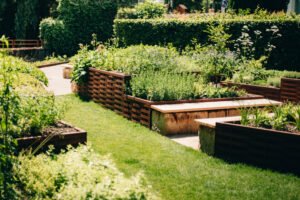
Herbularius by City of Luxembourg, LUGA and Niki Kirsch (source: LUGA)
At the end of the valley, we pass the Herbularius, a contemporary herb garden that recalls the apothecary gardens of earlier centuries. Medicinal and culinary herbs are carefully arranged in metal beds and box hedges, connecting biodiversity to everyday health practices.

Le Chant d’Alzette by Recine Carrée and Atelier Ty (left; source: Marion Dessard) and Les Périscopes by Atelier LJN (right; source: LUGA)
Entering the Alzette valley, the scale of the elements becomes larger. Le chant de l’Alzette interprets the sound of the river through colour. Following Isaac Newton’s historical link between the colour spectrum and musical notes, the garden arranges plants in rainbow hues to give form to the invisible song of the water. Right behind it, a wooden structure – Les Périscopes – with mirrors functions like a periscope. Inspired by the city’s military history, it shifts perspectives by creating new sightlines over the landscape.
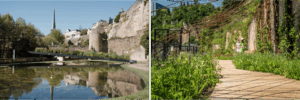
Water Forum by LOLA Landscape Architects, 2001 and 51N4E (left, source: LUGA) and Racines du Futur by Atelier eem and Paysarchitectures (right; source: Marion Dessard)
Not far from here, the Water Forum demonstrates how plants can filter and clean water. The installation is supported by the University of Luxembourg, which uses it as a living laboratory to measure water quality and test purification techniques. The installation Racines du futur pushes another metaphor: large sculptural roots appear to grow out of the hillside and climbing plants colonise steel supports visualising the diversity of Luxembourgish society. Visitors step onto a balcony that projects into the valley from a different perspective.
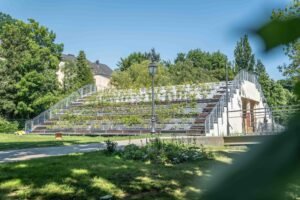
Grow Together Grow Green at the LUGA Lab (source: LUGA)
Crossing into Pfaffenthal, the LUGA Lab acts as one of the central hubs of the exhibition. It is an open-air forum where workshops, community cafés, sports sessions and repair kiosks are organised. Here, social inclusion and ecological awareness are brought together, creating a place where different audiences can meet. At the same location, the installation Grow Together Grow Green shows rows of seedlings on a tiered platform. Visitors can adopt trees, linking their personal experience of LUGA to long-term reforestation and climate action.
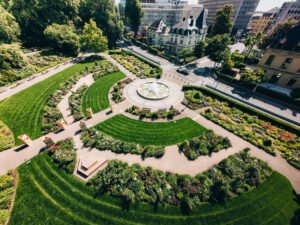
La Roseraie Amélie by the City of Luxembourg (source: LUGA)
The panorama lift then takes us up to the Édouard André municipal park, a 30-hectare landscape that has been part of the city for over a century. In front of the Fondation Pescatore, horticultural enterprises present show gardens. They are more classical in character and demonstrate the skills and aesthetics of Luxembourg’s horticultural sector. The Bionic Pergola for example, a chestnut-wood structure inspired by natural forms that provides shade and a meeting point. Further down in the park lies the Roseraie Amélie, a rose garden dedicated to women and linked to Luxembourg’s strong rose tradition. Here, a new rose variety named Amalia Rose was introduced. Finally, the park also hosts the LUGA Culture Hub with its pop-up gastronomy Mikrokosmos. It hosts concerts, readings and a seasonal menu underline that LUGA is not only about gardens but also about culture and everyday life in the city. Ann Muller underlines that this mix of gardens, art, and gastronomy is intentional. It is about showing that urban development is not only about architecture or streets but also about how people use and perceive public space together. For her, the most telling feedback is when visitors believe a LUGA element has always been there.
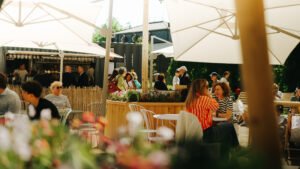
Mikrokosmos at the LUGA Culture Hub (source: LUGA)
Looking back across the sites, the exhibition clearly positions itself as an experiment. LUGA is full of temporary examples that showcase ideas in real-life settings. By linking ecological design with cultural activities and everyday use, the exhibition turns the city itself into a laboratory for future urban development. This walk only covered a selection of LUGA elements in Luxembourg City. Many more gardens, installations and events are part of the programme, as are the sites on Kirchberg and in Ettelbrück, which we did not visit that day. A second article will look into the programme and behind the scenes. It will discover how the idea for LUGA emerged, how different partners made it possible, and how the exhibition connects to Luxembourg’s urban development.
Contact and further information
LUGA: https://luga.lu/en/about/
LUGA contact: https://luga.lu/en/contact-us/





